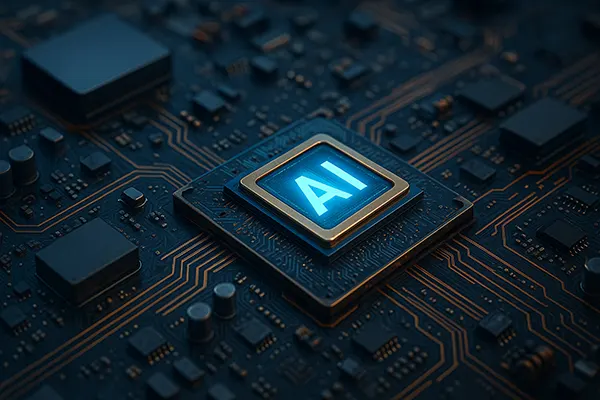
New Chip Architectures with Built-in AI for PCs: The Future of Personal Computing
The year 2025 marks a turning point in personal computing, where artificial intelligence (AI) is no longer a software feature but an integrated part of hardware itself. Major tech companies are reshaping the concept of CPUs and GPUs, embedding AI capabilities directly into the chip design. This transformation promises faster data processing, enhanced energy efficiency, and smarter system behaviour across both consumer and professional devices.
The Rise of AI-Powered Chips in Personal Computers
Over the last few years, the shift towards AI-driven workloads has forced hardware manufacturers to rethink traditional chip architecture. Conventional CPUs and GPUs, while powerful, struggle with the increasing demands of AI tasks such as real-time image recognition, voice synthesis, and predictive analytics. To solve this, new architectures combine general-purpose computing with Neural Processing Units (NPUs) that accelerate machine learning models directly on the device.
Microsoft, Apple, and Intel have already introduced chips with dedicated AI cores — the M4, Meteor Lake, and Snapdragon X Elite are notable examples. These processors are designed to offload AI computations from the CPU, allowing tasks like background image enhancement, speech-to-text transcription, and adaptive power management to run more efficiently.
The integration of AI cores also benefits data privacy and security. Instead of sending sensitive data to cloud servers for analysis, NPUs can perform computations locally, reducing exposure to potential cyber risks. This approach aligns with global trends toward on-device AI and digital sovereignty.
How Chip Design Is Evolving
Chip design in 2025 is defined by heterogeneous computing — a structure that combines CPU, GPU, and NPU components on a single die. This allows each unit to handle its own type of workload optimally. For instance, CPUs remain responsible for logic and control operations, while GPUs and NPUs take over tasks that rely on parallel computation.
Another key innovation is advanced packaging, such as Intel’s Foveros 3D stacking and AMD’s chiplet-based designs. These enable more transistors per square millimetre, greater flexibility in manufacturing, and better thermal management. The outcome is compact yet powerful processors capable of sustaining higher performance under demanding conditions.
Energy efficiency has become equally critical. AI workloads are power-intensive, and the industry’s focus is now on balancing performance per watt. This balance is achieved through smaller fabrication nodes, such as TSMC’s 3nm and upcoming 2nm processes, and intelligent task scheduling managed by AI itself.
Key Players and Market Direction
The competition in the AI chip market for PCs has never been stronger. Intel’s Core Ultra processors, AMD’s Ryzen AI series, and Qualcomm’s Snapdragon X Elite all feature built-in NPUs capable of over 40 trillion operations per second (TOPS). Apple’s latest M4 chip also integrates machine learning accelerators, allowing macOS applications to benefit from real-time AI processing.
These advances are not limited to high-end computers. By 2025, even mid-range laptops and desktops are expected to feature AI-optimised chips. This democratisation of technology will allow users to enjoy features like background noise suppression, adaptive battery optimisation, and real-time translation without relying on cloud connectivity.
Market analysts predict that by 2026, nearly 80% of new PCs will include hardware-level AI acceleration. This projection is supported by the growing demand for tools that leverage generative AI, image synthesis, and local inference models — all of which require powerful, efficient chips.
Partnerships and Ecosystem Development
Hardware development alone cannot drive the AI revolution; software integration is equally vital. Microsoft’s Windows Copilot+ initiative, for instance, is designed to fully utilise NPUs in compatible systems, enabling faster and more contextual responses. Similarly, Adobe and Autodesk have updated their creative tools to run AI features natively on supported chips.
Chip manufacturers are also collaborating with software developers to create optimised frameworks. Intel’s OpenVINO and AMD’s ROCm platforms allow developers to harness AI acceleration without rewriting entire applications. This ensures smoother adoption and consistent performance across devices.
These collaborations are shaping a broader ecosystem where AI becomes a seamless part of the computing experience. The result is a more intelligent, responsive, and personalised interaction between humans and machines, setting a new standard for productivity and innovation.

The Future of AI-Integrated Computing
Looking ahead, AI chip architecture will continue to evolve toward modularity and scalability. Future designs are expected to support dynamic reconfiguration, where processors can adapt their internal structure depending on workload type. This means that one chip could efficiently handle both deep learning models and traditional applications without compromise.
Security will also remain a top priority. With AI models running locally, protecting user data and ensuring model integrity will be critical. Hardware-based encryption and secure enclaves are becoming standard features of modern processors, ensuring that sensitive information never leaves the user’s device.
Finally, the rise of AI-integrated chips marks the beginning of a new technological paradigm. The boundary between hardware and intelligence is blurring, giving rise to computers that not only execute commands but also understand intent. This shift is set to redefine creativity, work efficiency, and human–machine collaboration in the coming decade.
Expected Challenges and Opportunities
Despite its rapid growth, the AI chip industry faces several challenges. Manufacturing complexity and rising production costs remain major concerns. As fabrication nodes shrink below 3nm, maintaining yield rates becomes increasingly difficult, demanding advanced lithography and quality control.
Another obstacle lies in software optimisation. Not all applications are ready to take full advantage of on-device AI capabilities, and developers must redesign algorithms to exploit parallel processing effectively. Industry standards are still forming, which can delay cross-platform compatibility.
Nevertheless, these challenges open the door to innovation. Companies that successfully balance hardware performance, power efficiency, and AI functionality will dominate the next generation of computing. For users, this means smarter PCs that learn, adapt, and assist like never before — not through cloud processing, but through intelligence built directly into the heart of the machine.
